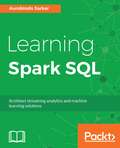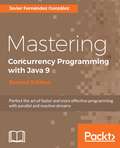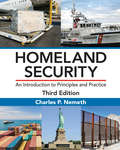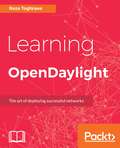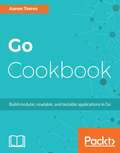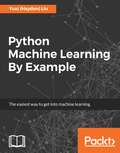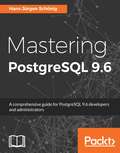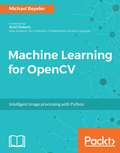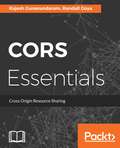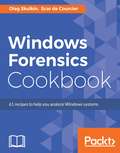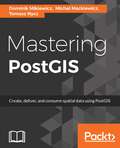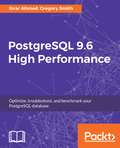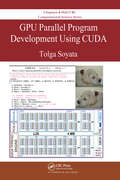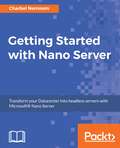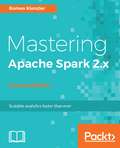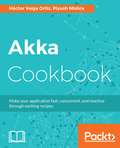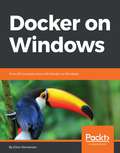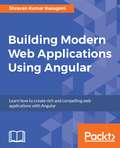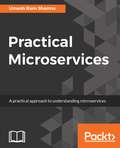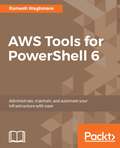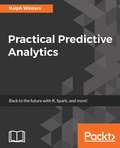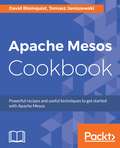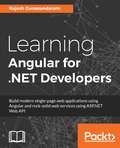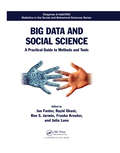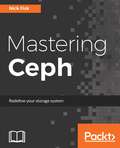- Table View
- List View
Learning Spark SQL
by Aurobindo SarkarDesign, implement, and deliver successful streaming applications, machine learning pipelines and graph applications using Spark SQL API About This Book • Learn about the design and implementation of streaming applications, machine learning pipelines, deep learning, and large-scale graph processing applications using Spark SQL APIs and Scala. • Learn data exploration, data munging, and how to process structured and semi-structured data using real-world datasets and gain hands-on exposure to the issues and challenges of working with noisy and "dirty" real-world data. • Understand design considerations for scalability and performance in web-scale Spark application architectures. Who This Book Is For If you are a developer, engineer, or an architect and want to learn how to use Apache Spark in a web-scale project, then this is the book for you. It is assumed that you have prior knowledge of SQL querying. A basic programming knowledge with Scala, Java, R, or Python is all you need to get started with this book. What You Will Learn • Familiarize yourself with Spark SQL programming, including working with DataFrame/Dataset API and SQL • Perform a series of hands-on exercises with different types of data sources, including CSV, JSON, Avro, MySQL, and MongoDB • Perform data quality checks, data visualization, and basic statistical analysis tasks • Perform data munging tasks on publically available datasets • Learn how to use Spark SQL and Apache Kafka to build streaming applications • Learn key performance-tuning tips and tricks in Spark SQL applications • Learn key architectural components and patterns in large-scale Spark SQL applications In Detail In the past year, Apache Spark has been increasingly adopted for the development of distributed applications. Spark SQL APIs provide an optimized interface that helps developers build such applications quickly and easily. However, designing web-scale production applications using Spark SQL APIs can be a complex task. Hence, understanding the design and implementation best practices before you start your project will help you avoid these problems. This book gives an insight into the engineering practices used to design and build real-world, Spark-based applications. The book's hands-on examples will give you the required confidence to work on any future projects you encounter in Spark SQL. It starts by familiarizing you with data exploration and data munging tasks using Spark SQL and Scala. Extensive code examples will help you understand the methods used to implement typical use-cases for various types of applications. You will get a walkthrough of the key concepts and terms that are common to streaming, machine learning, and graph applications. You will also learn key performance-tuning details including Cost Based Optimization (Spark 2.2) in Spark SQL applications. Finally, you will move on to learning how such systems are architected and deployed for a successful delivery of your project. Style and approach This book is a hands-on guide to designing, building, and deploying Spark SQL-centric production applications at scale.
Mastering Concurrency Programming with Java 9 - Second Edition
by Javier Fernandez GonzalezMaster the principles to make applications robust, scalable and responsive About This Book • Implement concurrent applications using the Java 9 Concurrency API and its new components • Improve the performance of your applications and process more data at the same time, taking advantage of all of your resources • Construct real-world examples related to machine learning, data mining, natural language processing, and more Who This Book Is For This book is for competent Java developers who have basic understanding of concurrency, but knowledge of effective implementation of concurrent programs or usage of streams for making processes more efficient is not required What You Will Learn • Master the principles that every concurrent application must follow • See how to parallelize a sequential algorithm to obtain better performance without data inconsistencies and deadlocks • Get the most from the Java Concurrency API components • Separate the thread management from the rest of the application with the Executor component • Execute phased-based tasks in an efficient way with the Phaser components • Solve problems using a parallelized version of the divide and conquer paradigm with the Fork / Join framework • Find out how to use parallel Streams and Reactive Streams • Implement the “map and reduce” and “map and collect” programming models • Control the concurrent data structures and synchronization mechanisms provided by the Java Concurrency API • Implement efficient solutions for some actual problems such as data mining, machine learning, and more In Detail Concurrency programming allows several large tasks to be divided into smaller sub-tasks, which are further processed as individual tasks that run in parallel. Java 9 includes a comprehensive API with lots of ready-to-use components for easily implementing powerful concurrency applications, but with high flexibility so you can adapt these components to your needs. The book starts with a full description of the design principles of concurrent applications and explains how to parallelize a sequential algorithm. You will then be introduced to Threads and Runnables, which are an integral part of Java 9's concurrency API. You will see how to use all the components of the Java concurrency API, from the basics to the most advanced techniques, and will implement them in powerful real-world concurrency applications. The book ends with a detailed description of the tools and techniques you can use to test a concurrent Java application, along with a brief insight into other concurrency mechanisms in JVM. Style and approach This is a complete guide that implements real-world examples of algorithms related to machine learning, data mining, and natural language processing in client/server environments. All the examples are explained using a step-by-step approach.
Homeland Security: An Introduction to Principles and Practice, Third Edition
by Charles P. NemethSince formed in 2002, DHS has been at the forefront of determining and furthering some of the most hotly debated security issues facing the U.S. and global community in the 21st century. Nearly 200 university programs with undergrad and graduate majors have cropped up in the last dozen-plus years with limited resources available to teach from. Homeland Security, Third Edition will continue to serve as the core textbook covering the fundamental history, formation, oversight, and reach of DHS currently. The book is fully updated with new laws, regulations and strategies across intelligence, transportation sectors, emergency management, border security, public utilities and public health.
Learning OpenDaylight
by Reza ToghraeeA practical guide to building programmable networks using OpenDaylight About This Book • Learn and understand how SDN controllers operate and integrate with networks; this book's step-by-step tutorials will give you a strong foundation in SDN, NVF, and OpenDayLight. • Learn how to map legacy Layer 2/3 networking technologies in the SDN world • Add new services and capabilities to your infrastructure and quickly adopt SDN and NFV within your organization with OpenDayLight. • Integrate and manage software-defined networks efficiently in your organization. • Build innovative network applications with OpenDayLight and save time and resources. Who This Book Is For This book targets network engineers, network programmers and developers, administrators, and anyone with some level of networking experience who'd like to deploy OpenDayLight effectively. Familiarity with the day-to-day operations of computer networks is expected What You Will Learn • Transition from legacy networking to software-defined networking • Learn how SDN controllers work and manage a network using southbound and northbound APIs • Learn how to deploy the OpenDayLight SDN controller and integrate it with virtual switches • Understand the basic design and operation of the OpenDaylight platform • Build simple MD-SAL OpenDaylight applications • Build applications on top of OpenDayLight to trigger network changes based on different events • Integrate OpenStack with OpenDayLight to build a fully managed network • Learn how to build a software-defined datacenter using NFV and service-chaining technologies In Detail OpenDaylight is an open source, software-defined network controller based on standard protocols. It aims to accelerate the adoption of Software-Defined Networking (SDN) and create a solid foundation for Network Functions Virtualization (NFV). SDN is a vast subject; many network engineers find it difficult to get started with using and operating different SDN platforms. This book will give you a practical bridge from SDN theory to the practical, real-world use of SDN in datacenters and by cloud providers. The book will help you understand the features and use cases for SDN, NFV, and OpenDaylight. NFV uses virtualization concepts and techniques to create virtual classes for node functions. Used together, SDN and NFV can elevate the standards of your network architecture; generic hardware-saving costs and the advanced and abstracted software will give you the freedom to evolve your network in the future without having to invest more in costly equipment. By the end of this book, you will have learned how to design and deploy OpenDaylight networks and integrate them with physical network switches. You will also have mastered basic network programming over the SDN fabric. Style and approach This is a step-by-step tutorial aimed at getting you up-to-speed with OpenDayLight and ready to adopt it for your SDN (Software-Defined Networking) and NFV (Network Functions Virtualization) ecosystem.
Go Cookbook
by Aaron TorresBridge the gap between basic understanding of Go and use of its advanced features About This Book • Discover a number of recipes and approaches to develop modern back-end applications • Put to use the best practices to combine the recipes for sophisticated parallel tools • This book is based on Go 1.8, which is the latest version Who This Book Is For This book is for web developers, programmers, and enterprise developers. Basic knowledge of the Go language is assumed. Experience with back-end application development is not necessary, but may help understand the motivation behind some of the recipes. What You Will Learn • Test your application using advanced testing methodologies • Develop an awareness of application structures, interface design, and tooling • Create strategies for third-party packages, dependencies, and vendoring • Get to know tricks on treating data such as collections • Handle errors and cleanly pass them along to calling functions • Wrap dependencies in interfaces for ease of portability and testing • Explore reactive programming design patterns in Go In Detail Go (a.k.a. Golang) is a statically-typed programming language first developed at Google. It is derived from C with additional features such as garbage collection, type safety, dynamic-typing capabilities, additional built-in types, and a large standard library. This book takes off where basic tutorials on the language leave off. You can immediately put into practice some of the more advanced concepts and libraries offered by the language while avoiding some of the common mistakes for new Go developers. The book covers basic type and error handling. It explores applications that interact with users, such as websites, command-line tools, or via the file system. It demonstrates how to handle advanced topics such as parallelism, distributed systems, and performance tuning. Lastly, it finishes with reactive and serverless programming in Go. Style and approach This guide is a handy reference for developers to quickly look up Go development patterns. It is a companion to other resources and a reference that will be useful long after reading it through the first time. Each recipe includes working, simple, and tested code that can be used as a reference or foundation for your own applications.
Python Machine Learning By Example
by Yuxi Hayden LiuTake tiny steps to enter the big world of data science through this interesting guide About This Book • Learn the fundamentals of machine learning and build your own intelligent applications • Master the art of building your own machine learning systems with this example-based practical guide • Work with important classification and regression algorithms and other machine learning techniques Who This Book Is For This book is for anyone interested in entering the data science stream with machine learning. Basic familiarity with Python is assumed. What You Will Learn • Exploit the power of Python to handle data extraction, manipulation, and exploration techniques • Use Python to visualize data spread across multiple dimensions and extract useful features • Dive deep into the world of analytics to predict situations correctly • Implement machine learning classification and regression algorithms from scratch in Python • Be amazed to see the algorithms in action • Evaluate the performance of a machine learning model and optimize it • Solve interesting real-world problems using machine learning and Python as the journey unfolds In Detail Data science and machine learning are some of the top buzzwords in the technical world today. A resurging interest in machine learning is due to the same factors that have made data mining and Bayesian analysis more popular than ever. This book is your entry point to machine learning. This book starts with an introduction to machine learning and the Python language and shows you how to complete the setup. Moving ahead, you will learn all the important concepts such as, exploratory data analysis, data preprocessing, feature extraction, data visualization and clustering, classification, regression and model performance evaluation. With the help of various projects included, you will find it intriguing to acquire the mechanics of several important machine learning algorithms – they are no more obscure as they thought. Also, you will be guided step by step to build your own models from scratch. Toward the end, you will gather a broad picture of the machine learning ecosystem and best practices of applying machine learning techniques. Through this book, you will learn to tackle data-driven problems and implement your solutions with the powerful yet simple language, Python. Interesting and easy-to-follow examples, to name some, news topic classification, spam email detection, online ad click-through prediction, stock prices forecast, will keep you glued till you reach your goal. Style and approach This book is an enticing journey that starts from the very basics and gradually picks up pace as the story unfolds. Each concept is first succinctly defined in the larger context of things, followed by a detailed explanation of their application. Every concept is explained with the help of a project that solves a real-world problem, and involves hands-on work—giving you a deep insight into the world of machine learning. With simple yet rich language—Python—you will understand and be able to implement the examples with ease.
Mastering PostgreSQL 9.6
by Hans-Jurgen SchonigMaster the capabilities of PostgreSQL 9.6 to efficiently manage and maintain your database About This Book • Your one-stop guide to mastering the advanced concepts in PostgreSQL with ease • Master query optimization, replication, and high availability with PostgreSQL • Extend the functionalities of PostgreSQL to suit your organizational needs with minimum effort Who This Book Is For If you are a PostgreSQL data architect or an administrator who wants to understand how to implement advanced functionalities and master complex administrative tasks with PostgreSQL, then this book is perfect for you. Prior experience of administrating a PostgreSQL database and a working knowledge of SQL is required to make the best use of this book. What You Will Learn • Get to grips with the advanced features of PostgreSQL 9.6 and handle advanced SQL • Make use of the indexing features in PostgreSQL and fine-tune the performance of your queries • Work with the stored procedures and manage backup and recovery • Master the replication and failover techniques • Troubleshoot your PostgreSQL instance for solutions to the common and not-so-common problems • Learn how to migrate your database from MySQL and Oracle to PostgreSQL without any hassle In Detail PostgreSQL is an open source database used for handling large datasets (Big Data) and as a JSON document database. It also has applications in the software and web domains. This book will enable you to build better PostgreSQL applications and administer databases more efficiently. We begin by explaining the advanced database design concepts in PostgreSQL 9.6, along with indexing and query optimization. You will also see how to work with event triggers and perform concurrent transactions and table partitioning, along with exploring SQL and server tuning. We will walk you through implementing advanced administrative tasks such as server maintenance and monitoring, replication, recovery and high availability, and much more. You will understand the common and not-so-common troubleshooting problems and how you can overcome them. By the end of this book, you will have an expert-level command of the advanced database functionalities and will be able to implement advanced administrative tasks with PostgreSQL. Style and Approach This book is a comprehensive guide covering all the concepts you need to master PostgreSQL. Packed with hands-on examples, tips and tricks, even the most advanced concepts are explained in a very easy-to-follow manner. Every chapter in the book does not only focus on how each task is performed, but also why.
Machine Learning for OpenCV
by Michael BeyelerExpand your OpenCV knowledge and master key concepts of machine learning using this practical, hands-on guide. About This Book • Load, store, edit, and visualize data using OpenCV and Python • Grasp the fundamental concepts of classification, regression, and clustering • Understand, perform, and experiment with machine learning techniques using this easy-to-follow guide • Evaluate, compare, and choose the right algorithm for any task Who This Book Is For This book targets Python programmers who are already familiar with OpenCV; this book will give you the tools and understanding required to build your own machine learning systems, tailored to practical real-world tasks. What You Will Learn • Explore and make effective use of OpenCV's machine learning module • Learn deep learning for computer vision with Python • Master linear regression and regularization techniques • Classify objects such as flower species, handwritten digits, and pedestrians • Explore the effective use of support vector machines, boosted decision trees, and random forests • Get acquainted with neural networks and Deep Learning to address real-world problems • Discover hidden structures in your data using k-means clustering • Get to grips with data pre-processing and feature engineering In Detail Machine learning is no longer just a buzzword, it is all around us: from protecting your email, to automatically tagging friends in pictures, to predicting what movies you like. Computer vision is one of today's most exciting application fields of machine learning, with Deep Learning driving innovative systems such as self-driving cars and Google's DeepMind. OpenCV lies at the intersection of these topics, providing a comprehensive open-source library for classic as well as state-of-the-art computer vision and machine learning algorithms. In combination with Python Anaconda, you will have access to all the open-source computing libraries you could possibly ask for. Machine learning for OpenCV begins by introducing you to the essential concepts of statistical learning, such as classification and regression. Once all the basics are covered, you will start exploring various algorithms such as decision trees, support vector machines, and Bayesian networks, and learn how to combine them with other OpenCV functionality. As the book progresses, so will your machine learning skills, until you are ready to take on today's hottest topic in the field: Deep Learning. By the end of this book, you will be ready to take on your own machine learning problems, either by building on the existing source code or developing your own algorithm from scratch! Style and approach OpenCV machine learning connects the fundamental theoretical principles behind machine learning to their practical applications in a way that focuses on asking and answering the right questions. This book walks you through the key elements of OpenCV and its powerful machine learning classes, while demonstrating how to get to grips with a range of models.
CORS Essentials
by Rajesh Gunasundaram Randall GoyaShare code and assets across domains in Web applications with CORS About This Book • A step-by-step guide but at a high level/fast pace. Not all steps are covered as a basic knowledge is assumed • Provides a basic overview of the concepts but the focus is on providing the practical skills required to develop applications • Focuses on providing practical examples Who This Book Is For Web developers have been limited by the Same Origin Policy and often wish they could spread their application across different domains. You know JavaScript and AJAX, and have run up against the Same Domain Policy, which is limiting your applications. What You Will Learn • Why you need CORS: Bending the Same Origin Policy and basic CORS implementation, headers and XMLHttpRequest • Creating proxies for CORS: Sometimes the header is not enough • Security: vulnerabilities and how to secure your CORS application • CORS implementations in Content Management systems • Learn about CORS in Windows applications • Take CORS on the Cloud • Apply CORS in Node.js • Best practices for CORS In Detail This book explains how to use CORS, including specific implementations for platforms such as Drupal, WordPress, IIS Server, ASP.NET, JBoss, Windows Azure, and Salesforce, as well as how to use CORS in the Cloud on Amazon AWS, YouTube, Mulesoft, and others. It examines limitations, security risks, and alternatives to CORS. It explores the W3C Specification and major developer documentation sources about CORS. It attempts to predict what kinds of extension to the CORS specification, or completely new techniques, will come in the future to address the limitations of CORS Web developers will learn how to share code and assets across domains with CORS. They will learn a variety of techniques that are rather similar in their method and syntax. The book is organized by similar types of framework and application, so it can be used as a reference. Developers will learn about special cases, such as when a proxy is necessary. And they will learn about some alternative techniques that achieve similar goals, and when they may be preferable to using CORS Style and approach A step-by-step guide filled with real-world applications
Windows Forensics Cookbook
by Oleg Skulkin Scar De CourcierMaximize the power of Windows Forensics to perform highly effective forensic investigations About This Book • Prepare and perform investigations using powerful tools for Windows, • Collect and validate evidence from suspects and computers and uncover clues that are otherwise difficult • Packed with powerful recipes to perform highly effective field investigations Who This Book Is For If you are a forensic analyst or incident response professional who wants to perform computer forensics investigations for the Windows platform and expand your took kit, then this book is for you. What You Will Learn • Understand the challenges of acquiring evidence from Windows systems and overcome them • Acquire and analyze Windows memory and drive data with modern forensic tools. • Extract and analyze data from Windows file systems, shadow copies and the registry • Understand the main Windows system artifacts and learn how to parse data from them using forensic tools • See a forensic analysis of common web browsers, mailboxes, and instant messenger services • Discover how Windows 10 differs from previous versions and how to overcome the specific challenges it presents • Create a graphical timeline and visualize data, which can then be incorporated into the final report • Troubleshoot issues that arise while performing Windows forensics In Detail Windows Forensics Cookbook provides recipes to overcome forensic challenges and helps you carry out effective investigations easily on a Windows platform. You will begin with a refresher on digital forensics and evidence acquisition, which will help you to understand the challenges faced while acquiring evidence from Windows systems. Next you will learn to acquire Windows memory data and analyze Windows systems with modern forensic tools. We also cover some more in-depth elements of forensic analysis, such as how to analyze data from Windows system artifacts, parse data from the most commonly-used web browsers and email services, and effectively report on digital forensic investigations. You will see how Windows 10 is different from previous versions and how you can overcome the specific challenges it brings. Finally, you will learn to troubleshoot issues that arise while performing digital forensic investigations. By the end of the book, you will be able to carry out forensics investigations efficiently. Style and approach This practical guide filled with hands-on, actionable recipes to detect, capture, and recover digital artifacts and deliver impeccable forensic outcomes.
Mastering PostGIS
by Dominik Mikiewicz Michal Mackiewicz Tomasz NyczWrite efficient GIS applications using PostGIS - from data creation to data consumption About This Book • Learn how you can use PostGIS for spatial data analysis and manipulation • Optimize your queries and build custom functionalities for your GIS application • A comprehensive guide with hands-on examples to help you master PostGIS with ease Who This Book Is For If you are a GIS developer or analyst who wants to master PostGIS to build efficient, scalable GIS applications, this book is for you. If you want to conduct advanced analysis of spatial data, this book will also help you. The book assumes that you have a working installation of PostGIS in place, and have working experience with PostgreSQL. What You Will Learn • Refresh your knowledge of the PostGIS concepts and spatial databases • Solve spatial problems with the use of SQL in real-world scenarios • Practical walkthroughs of application development examples using Postgis, GeoServer and OpenLayers. • Extract, transform and load your spatial data • Expose data directly or through web services. • Consume your data in both desktop and web clients In Detail PostGIS is open source extension onf PostgreSQL object-relational database system that allows GIS objects to be stored and allows querying for information and location services. The aim of this book is to help you master the functionalities offered by PostGIS- from data creation, analysis and output, to ETL and live edits. The book begins with an overview of the key concepts related to spatial database systems and how it applies to Spatial RMDS. You will learn to load different formats into your Postgres instance, investigate the spatial nature of your raster data, and finally export it using built-in functionalities or 3th party tools for backup or representational purposes. Through the course of this book, you will be presented with many examples on how to interact with the database using JavaScript and Node.js. Sample web-based applications interacting with backend PostGIS will also be presented throughout the book, so you can get comfortable with the modern ways of consuming and modifying your spatial data. Style and approach This book is a comprehensive guide covering all the concepts you need to master PostGIS. Packed with hands-on examples, tips and tricks, even the most advanced concepts are explained in a very easy-to-follow manner. Every chapter in the book does not only focus on how each task is performed, but also why.
PostgreSQL 9.6 High Performance
by Gregory Smith Ibrar AhmedEnhance the performance of your PostgreSQL system with this handy guide while avoiding common pitfalls that can slow it down. About This Book • Learn the right techniques to obtain optimal PostgreSQL database performance, ranging from initial design to routine maintenance • Fine tune the performance of your queries and avoid the common pitfalls that can slow your system down • Contains tips and tricks on scaling successful database installations, and ensuring a highly available PostgreSQL solution Who This Book Is For This book is for intermediate to advanced database administrators and developers who use or plan to exploit the features of PostgreSQL in the best possible manner. While administrators can benefit from the topics related to the installation, configuration, and optimization of the server, developers will learn how to write optimal queries and address performance issues in their database design. This book will also benefit the PostgreSQL internal architects in being able to monitor the performance using benchmarking tools. What You Will Learn • Learn the best practices to configure your PostgreSQL 9.6 database for optimal performance • Write optimal queries and techniques to detect performance issue in queries • Fine tune the performance of your queries using benchmarking and indexing techniques • Ensure high performance and a highly available database using the scaling and replication techniques • Discover how to make informed speed and reliability trade-offs • Handle increasing database workloads without any hassle • Use monitoring insights to continuously rework the design and configuration for best performance In Detail Database administrators and developers spend years learning techniques to configure their PostgreSQL database servers for optimal performance, mostly when they encounter performance issues. Scalability and high availability of the database solution is equally important these days. This book will show you how to configure new database installations and optimize existing database server installations using PostgreSQL 9.6. You will start with the basic concepts of database performance, because all successful database applications are destined to eventually run into issues when scaling up their performance. You will not only learn to optimize your database and queries for optimal performance, but also detect the real performance bottlenecks using PostgreSQL tools and some external tools. Next, you will learn how to benchmark your hardware and tune your operating system. Optimize your queries against the database with the help of right indexes, and monitor every layer, ranging from hardware to queries. Moving on, you will see how connection pooling, caching, partitioning, and replication will help you handle increasing database workloads. Achieving high database performance is not easy, but you can learn it by using the right guide—PostgreSQL 9.6 High Performance. Style and approach This book has been organized in such a manner that will help you understand basic PostgreSQL 9.6 performance tuning to advanced-level configuration. There are many real-world problems explained in this book and explained in clear language, because improving database performance requires an equal mix of understanding theoretical concepts and working through hands-on examples.
GPU Parallel Program Development Using CUDA (Chapman & Hall/CRC Computational Science)
by Tolga SoyataGPU Parallel Program Development using CUDA teaches GPU programming by showing the differences among different families of GPUs. This approach prepares the reader for the next generation and future generations of GPUs. The book emphasizes concepts that will remain relevant for a long time, rather than concepts that are platform-specific. At the same time, the book also provides platform-dependent explanations that are as valuable as generalized GPU concepts. The book consists of three separate parts; it starts by explaining parallelism using CPU multi-threading in Part I. A few simple programs are used to demonstrate the concept of dividing a large task into multiple parallel sub-tasks and mapping them to CPU threads. Multiple ways of parallelizing the same task are analyzed and their pros/cons are studied in terms of both core and memory operation. Part II of the book introduces GPU massive parallelism. The same programs are parallelized on multiple Nvidia GPU platforms and the same performance analysis is repeated. Because the core and memory structures of CPUs and GPUs are different, the results differ in interesting ways. The end goal is to make programmers aware of all the good ideas, as well as the bad ideas, so readers can apply the good ideas and avoid the bad ideas in their own programs. Part III of the book provides pointer for readers who want to expand their horizons. It provides a brief introduction to popular CUDA libraries (such as cuBLAS, cuFFT, NPP, and Thrust),the OpenCL programming language, an overview of GPU programming using other programming languages and API libraries (such as Python, OpenCV, OpenGL, and Apple’s Swift and Metal,) and the deep learning library cuDNN.
Getting Started with Nano Server
by Charbel NemnomRemain highly competitive in the server and VM market by gaining the practical skills needed to operate Nano Server About This Book • The days of the local server are numbered, and this book will make you an ace by giving you the skills needed to administer Nano Server and survive in the brave new server world • Learn to quickly automate multiple VMs and support Hyper-V clusters, all through small footprints from a single host • Apply up-to-date, real-world examples presented in this book and improve the scalability and efficiency of large-scale VM deployments Who This Book Is For This book opens up new potential for both developers and IT pros alike. The book is primarily for Server administrators and IT Professionals who would like to deploy and administer Nano Server within their organizations, and for developers who are trying to make maximal use of Server Containers and Hyper-V Containers with Nano Servers. What You Will Learn • Understand Nano Server • Deploy Nano Server • Deploy Hyper-V Clusters on Nano Server • Deploy Nano Server with SCVMM • Manage Nano Server using PowerShell and Remote Server Management Tools • Manage Nano Server with third-party tools • Run Server Containers and Hyper-V Containers on Nano Server • Troubleshoot Nano Server • Validate developed applications that run on Nano Server In Detail Nano Server allows developers and operations teams to work closely together and use containers that package applications so that the entire platform works as one. The aim of Nano Server is to help applications run the way they are intended to. It can be used to run and deploy infrastructures (acting as a compute host, storage host, container, or VM guest operating system) without consuming significant resources. Although Nano Server isn't intended to replace Server 2016 or 2012 R2, it will be an attractive choice for developers and IT teams. Want to improve your ability to deploy a new VM and install and deploy container apps within minutes? You have come to the right place! The objective of this book is to get you started with Nano Server successfully. The journey is quite exciting, since we are introducing you to a cutting-edge technology that will revolutionize today's datacenters. We'll cover everything from the basic to advanced topics. You'll discover a lot of added value from using Nano Server, such as hundreds of VM types on a single host through a small footprint, which could be a big plus for you and your company. After reading this book, you will have the necessary skills to start your journey effectively using Nano Server. Style and approach Gauge all the information needed to get up-and-running with the latest Nano Server built by Microsoft using this easy to follow step-by-step guide.
Mastering Apache Spark 2.x - Second Edition
by Romeo KienzlerAdvanced analytics on your Big Data with latest Apache Spark 2.x About This Book • An advanced guide with a combination of instructions and practical examples to extend the most up-to date Spark functionalities. • Extend your data processing capabilities to process huge chunk of data in minimum time using advanced concepts in Spark. • Master the art of real-time processing with the help of Apache Spark 2.x Who This Book Is For If you are a developer with some experience with Spark and want to strengthen your knowledge of how to get around in the world of Spark, then this book is ideal for you. Basic knowledge of Linux, Hadoop and Spark is assumed. Reasonable knowledge of Scala is expected. What You Will Learn • Examine Advanced Machine Learning and DeepLearning with MLlib, SparkML, SystemML, H2O and DeepLearning4J • Study highly optimised unified batch and real-time data processing using SparkSQL and Structured Streaming • Evaluate large-scale Graph Processing and Analysis using GraphX and GraphFrames • Apply Apache Spark in Elastic deployments using Jupyter and Zeppelin Notebooks, Docker, Kubernetes and the IBM Cloud • Understand internal details of cost based optimizers used in Catalyst, SystemML and GraphFrames • Learn how specific parameter settings affect overall performance of an Apache Spark cluster • Leverage Scala, R and python for your data science projects In Detail Apache Spark is an in-memory cluster-based parallel processing system that provides a wide range of functionalities such as graph processing, machine learning, stream processing, and SQL. This book aims to take your knowledge of Spark to the next level by teaching you how to expand Spark's functionality and implement your data flows and machine/deep learning programs on top of the platform. The book commences with an overview of the Spark ecosystem. It will introduce you to Project Tungsten and Catalyst, two of the major advancements of Apache Spark 2.x. You will understand how memory management and binary processing, cache-aware computation, and code generation are used to speed things up dramatically. The book extends to show how to incorporate H20, SystemML, and Deeplearning4j for machine learning, and Jupyter Notebooks and Kubernetes/Docker for cloud-based Spark. During the course of the book, you will learn about the latest enhancements to Apache Spark 2.x, such as interactive querying of live data and unifying DataFrames and Datasets. You will also learn about the updates on the APIs and how DataFrames and Datasets affect SQL, machine learning, graph processing, and streaming. You will learn to use Spark as a big data operating system, understand how to implement advanced analytics on the new APIs, and explore how easy it is to use Spark in day-to-day tasks. Style and approach This book is an extensive guide to Apache Spark modules and tools and shows how Spark's functionality can be extended for real-time processing and storage with worked examples.
Akka Cookbook
by Hector Veiga Ortiz Piyush MishraLearn how to use the Akka framework to build effective applications in Scala About This Book • Covers a discussion on Lagom—the newest launched Akka framework that is built to create complex microservices easily • The recipe approach of the book allows the reader to know important and independent concepts of Scala and Akka in a seamless manner • Provides a comprehensive understanding of the Akka actor model and implementing it to create reactive web applications Who This Book Is For If you are a Scala developer who wants to build scalable and concurrent applications, then this book is for you. Basic knowledge of Akka will help you take advantage of this book. What You Will Learn • Control an actor using the ContolAware mailbox • Test a fault-tolerant application using the Akka test kit • Create a parallel application using futures and agents • Package and deploy Akka application inside Docker • Deploy remote actors programmatically on different nodes • Integrate Streams with Akka actors • Install Lagom and create a Lagom project In Detail Akka is an open source toolkit that simplifies the construction of distributed and concurrent applications on the JVM. This book will teach you how to develop reactive applications in Scala using the Akka framework. This book will show you how to build concurrent, scalable, and reactive applications in Akka. You will see how to create high performance applications, extend applications, build microservices with Lagom, and more. We will explore Akka's actor model and show you how to incorporate concurrency into your applications. The book puts a special emphasis on performance improvement and how to make an application available for users. We also make a special mention of message routing and construction. By the end of this book, you will be able to create a high-performing Scala application using the Akka framework. Style and approach This highly practical recipe-based approach will allow you to build scalable, robust, and reactive applications using the Akka framework.
Docker on Windows
by Elton StonemanLearn how to run new and old Windows applications in Docker containers. About This Book • Package traditional .NET Frameworks apps and new .NET Core apps as Docker images, and run them in containers for increased efficiency, portability, and security • Design and implement distributed applications that run across connected containers, using enterprise-grade open source software from public Docker images • Build a full Continuous Deployment pipeline for a .NET Framework application, and deploy it to a highly-available Docker swarm running in the cloud Who This Book Is For If you want to modernize an old monolithic application without rewriting it, smooth the deployment to production, or move to DevOps or the cloud, then Docker is the enabler for you. This book gives you a solid grounding in Docker so you can confidently approach all of these scenarios. What You Will Learn • Comprehend key Docker concepts: images, containers, registries, and swarms • Run Docker on Windows 10, Windows Server 2016, and in the cloud • Deploy and monitor distributed solutions across multiple Docker containers • Run containers with high availability and fail-over with Docker Swarm • Master security in-depth with the Docker platform, making your apps more secure • Build a Continuous Deployment pipeline by running Jenkins in Docker • Debug applications running in Docker containers using Visual Studio • Plan the adoption of Docker in your own organization In Detail Docker is a platform for running server applications in lightweight units called containers. You can run Docker on Windows Server 2016 and Windows 10, and run your existing apps in containers to get significant improvements in efficiency, security, and portability. This book teaches you all you need to know about Docker on Windows, from 101 to deploying highly-available workloads in production. This book takes you on a Docker journey, starting with the key concepts and simple examples of how to run .NET Framework and .NET Core apps in Windows Docker containers. Then it moves on to more complex examples—using Docker to modernize the architecture and development of traditional ASP.NET and SQL Server apps. The examples show you how to break up monoliths into distributed apps and deploy them to a clustered environment in the cloud, using the exact same artifacts you use to run them locally. To help you move confidently to production, it then explains Docker security, and the management and support options. The book finishes with guidance on getting started with Docker in your own projects, together with some real-world case studies for Docker implementations, from small-scale on-premises apps to very large-scale apps running on Azure. Style and approach Using a step-by-step approach, this book shows you how to use Docker on Windows. It includes practical examples and real-world technical and business scenarios that will help you effectively implement Docker in your environment.There are over 50 examples of Dockerized applications, using C# .NET projects as the source and packaging them into Docker images.
Building Modern Web Applications Using Angular
by Shravan Kumar KasagoniDesign and develop next generation web applications using Angular 2 and Angular 4 About This Book • Learn about the core building blocks of Angular • Build and architect high performance web applications • Implement the latest JavaScript concepts in ECMAScript 2015, ECMAScript 2016, and TypeScript • Leverage the latest Angular features to get the most out of your web applications Who This Book Is For This book is targeted at JavaScript developers who are interested in learning how to build rich and powerful web applications with the latest version of Angular. Working knowledge of Angular 1 will be beneficial. What You Will Learn • Develop a frontend web application using component-based architecture • Use ES5, ES2015, and TypeScript to build Angular 4 UI applications • Develop simple to complex user interfaces in Angular 4 • Develop and handle forms in Angular 4 UI applications • Test UIs built in Angular 4 • Use material design components and animations in Angular 4 In Detail In the last few years, Angular has established itself as the number one choice of JavaScript Developers. What makes Angular special is performance and productivity. With Angular, developers can work on consistent coding patterns and build web applications that are powerful and scalable. This book will you get you up and running with Angular and teach how to build modern web applications. It starts with basics of Angular 2 and then brushes you up with the new features of Angular 4. You will learn the core concepts involved in building web applications with Angular such as Data Binding, Routing, Dependency Injection, and much more. The book teaches how to build components and use them to build web apps of your choice. It will help you to handle different kinds of forms and learn the concept of reactive programming. Finally the book teaches how to build visually appealing and responsive UIs. Style and approach It follows a practical approach to explain almost every feature of Angular 2 and Angular 4 and their concepts through real-world examples. In each chapter, a different example is used so that you can build a foundation and understand the concepts by applying them in different scenarios.
Practical Microservices
by Umesh Ram SharmaLearn how to implement the microservice architecture using Java About This Book • Leverage the power of microservices to build a flexible and efficient system in Java • See Docker and Spring Boot in practice to form easily deployable microservices • Hands-on approach throughout the book in order to familiarize and grasp the details Who This Book Is For This book is for Java developers who want to get started with microservices and implement it in their workplace. No knowledge of microservice is necessary. What You Will Learn • The role of a discovery service and externalized configuration in the overall architecture • Use of message brokers for event driven microservices • How to intermix data management strategies across components • Implementing different types of tests in Spring Boot environment • Applying CI to our microservices style architecture • Walk through of monitoring and scaling the sample application In Detail A microservice architecture helps you build your application as a suite of different services. This approach has been widely adopted as it helps to easily scale up your application with reduced dependencies. This way if a part of your application is corrupted, it can be fixed easily thereby eliminating the possibility of completely shutting down your software. This book will teach you how to leverage Java to build scalable microservices. You will learn the fundamentals of this architecture and how to efficiently implement it practically. We start off with a brief introduction to the microservice architecture and how it fares with the other architectures. The book dives deep into essential microservice components and how to set up seamless communication between two microservice end points. You will create an effective data model and learn different ways to test and deploy a microservices. You will also learn the best way to migrate your software from a monolith to a microservice architecture. Finishing off with monitoring, scaling and troubleshooting, this book will set a solid foundation for you to start implementing microservices. Style and approach Starting with the fundamentals, this book explains all the essential concepts gradually with the help of numerous examples.
AWS Tools for PowerShell 6
by Ramesh WaghmareLeverage the power of PowerShell to bring the best out of your AWS infrastructure About This Book • A collection of real-world-tested Powershell scripts that can be used to manage your Windows server efficiently • Follow step-by-step processes to solve your problems with Windows servers using AWS tools • Design examples that work in the Amazon free usage tier, which lets you run the Windows platform on cloud Who This Book Is For This book will be useful for (but not limited to) Windows System administrators, cloud engineers, architects, DevOps engineers, and all those who want to accomplish tasks on the AWS Public Cloud using PowerShell. What You Will Learn • Install the AWS Tools for PowerShell 6 • Understand key services provided by Amazon Web services (AWS) • Understand the Virtual Private Cloud • Use PowerShell 6 for AWS Identity and Access Management (IAM) • Use PowerShell 6 for AWS Elastic Compute Cloud (EC2) • Use PowerShell 6 for AWS Simple Storage Service (S3) • Use PowerShell 6 for AWS Relational Database Service (RDS) • Build fault-tolerant and highly-available applications using PowerShell 6 In Detail AWS Tools for PowerShell 6 shows you exactly how to automate all the aspects of AWS. You can take advantage of the amazing power of the cloud, yet add powerful scripts and mechanisms to perform common tasks faster than ever before. This book expands on the Amazon documentation with real-world, useful examples and production-ready scripts to automate all the aspects of your new cloud platform. It will cover topics such as managing Windows with PowerShell, setting up security services, administering database services, and deploying and managing networking. You will also explore advanced topics such as PowerShell authoring techniques, and configuring and managing storage and content delivery. By the end of this book, you will be able to use Amazon Web Services to automate and manage Windows servers. You will also have gained a good understanding of automating the AWS infrastructure using simple coding. Style and approach This step-by-step guide starts with simple examples then expands to full-blown administrative tasks leading to the efficient management of Windows servers. Each topic covers a section related to Amazon Web Services products, and the examples are built on one another to deliver a comprehensive library of scripts for administrators.
Practical Predictive Analytics
by Ralph WintersThis book teaches six specific steps needed to implement predictive analytics using R. It also teaches how team collaboration is critical and how it increases the chances of implementing a successful model. The book uses cases from healthcare, marketing, and government to build practical skills. Big Data is also covered, in this book, which will extend your skill sets by learning Databricks and RSpark.
Apache Mesos Cookbook
by David Blomquist Tomasz JaniszewskiOver 50 recipes on the core features of Apache Mesos and running big data frameworks in Mesos About This Book • Learn to install and configure Mesos to suit the needs of your organization • Follow step-by-step instructions to deploy application frameworks on top of Mesos, saving you many hours of research and trial and error • Use this practical guide packed with powerful recipes to implement Mesos and easily integrate it with other application frameworks Who This Book Is For This book is for system administrators, engineers, and big data programmers. Basic experience with big data technologies such as Hadoop or Spark would be useful but is not essential. A working knowledge of Apache Mesos is expected. What You Will Learn • Set up Mesos on different operating systems • Use the Marathon and Chronos frameworks to manage multiple applications • Work with Mesos and Docker • Integrate Mesos with Spark and other big data frameworks • Use networking features in Mesos for effective communication between containers • Configure Mesos for high availability using Zookeeper • Secure your Mesos clusters with SASL and Authorization ACLs • Solve everyday problems and discover the best practices In Detail Apache Mesos is open source cluster sharing and management software. Deploying and managing scalable applications in large-scale clustered environments can be difficult, but Apache Mesos makes it easier with efficient resource isolation and sharing across application frameworks. The goal of this book is to guide you through the practical implementation of the Mesos core along with a number of Mesos supported frameworks. You will begin by installing Mesos and then learn how to configure clusters and maintain them. You will also see how to deploy a cluster in a production environment with high availability using Zookeeper. Next, you will get to grips with using Mesos, Marathon, and Docker to build and deploy a PaaS. You will see how to schedule jobs with Chronos. We'll demonstrate how to integrate Mesos with big data frameworks such as Spark, Hadoop, and Storm. Practical solutions backed with clear examples will also show you how to deploy elastic big data jobs. You will find out how to deploy a scalable continuous integration and delivery system on Mesos with Jenkins. Finally, you will configure and deploy a highly scalable distributed search engine with ElasticSearch. Throughout the course of this book, you will get to know tips and tricks along with best practices to follow when working with Mesos. Style and approach This step-by-step guide is packed with powerful recipes on using Apache Mesos and shows its integration with containers and big data frameworks.
Learning Angular for .NET Developers
by Rajesh GunasundaramBuild efficient web apps and deliver great results by integrating Angular and the .NET framework About This Book • Become a more productive developer and learn to use frameworks that implement good development practices • Achieve advanced autocompletion, navigation, and refactoring in Angular using Typescript • Follow a gradual introduction to the concepts with a lot of examples and explore the evolution of a production-ready application Who This Book Is For If you are a .NET developer who now wants to efficiently build single-page applications using the new features that Angular 4 has to offer, then this book is for you. Familiarity of HTML, CSS, and JavaScript is assumed to get the most from this book. What You Will Learn • Create a standalone Angular application to prototype user interfaces • Validate complex forms with Angular version 4 and use Bootstrap to style them • Build RESTful web services that work well with single-page applications • Use Gulp and Bower in Visual Studio to run tasks and manage JavaScript packages • Implement automatic validation for web service requests to reduce your boilerplate code • Use web services with Angular version 4 to offload and secure your application logic • Test your Angular version 4 and web service code to improve the quality of your software deliverables In Detail Are you are looking for a better, more efficient, and more powerful way of building front-end web applications? Well, look no further, you have come to the right place! This book comprehensively integrates Angular version 4 into your tool belt, then runs you through all the new options you now have on hand for your web apps without bogging you down. The frameworks, tools, and libraries mentioned here will make your work productive and minimize the friction usually associated with building server-side web applications. Starting off with building blocks of Angular version 4, we gradually move into integrating TypeScript and ES6. You will get confident in building single page applications and using Angular for prototyping components. You will then move on to building web services and full-stack web application using ASP.NET WebAPI. Finally, you will learn the development process focused on rapid delivery and testability for all application layers. Style and approach This book covers everything there is to know about getting well-acquainted with Angular 4 and .NET without bogging you down. Everything is neatly laid out under clear headings for quick consultation, offering you the information required to understand a concept immediately, with short, relevant examples of each feature.
Big Data and Social Science: A Practical Guide to Methods and Tools (Chapman & Hall/CRC Statistics in the Social and Behavioral Sciences)
by Ian Foster Rayid Ghani Ron S. Jarmin Frauke Kreuter Julia LaneBoth Traditional Students and Working Professionals Acquire the Skills to Analyze Social Problems. Big Data and Social Science: A Practical Guide to Methods and Tools shows how to apply data science to real-world problems in both research and the practice. The book provides practical guidance on combining methods and tools from computer science, statistics, and social science. This concrete approach is illustrated throughout using an important national problem, the quantitative study of innovation. The text draws on the expertise of prominent leaders in statistics, the social sciences, data science, and computer science to teach students how to use modern social science research principles as well as the best analytical and computational tools. It uses a real-world challenge to introduce how these tools are used to identify and capture appropriate data, apply data science models and tools to that data, and recognize and respond to data errors and limitations. For more information, including sample chapters and news, please visit the author's website.
Mastering Ceph
by Nick FiskDeep dive into the unified, distributed storage system in order to provide excellent performance About This Book • Leverage Ceph's advanced features such as erasure coding, tiering, and Bluestore • Solve large-scale problems with Ceph as a tool by understanding its strengths and weaknesses to develop the best solutions • A practical guide that covers engaging use cases to help you use advanced features of Ceph effectively Who This Book Is For If you are a developer and an administrator who has deployed a Ceph cluster before and are curious about some of the most advanced features in order to improve performance then this book is for you What You Will Learn •Know when and how to use some of Ceph's advanced new features • Set up a test cluster with Ansible and some virtual machines using VirtualBox and Vagrant •Develop novel solutions to massive problems with librados and shared object classes. • Choose intelligent parameters for an erasure coded pool and set it up. • Configure the Bluestore settings and see how they interact with different hardware configurations. • Keep Ceph running through thick and thin with tuning, monitoring and disaster recovery advice. In Detail Mastering Ceph covers all that you need to know to use Ceph effectively. Starting with design goals and planning steps that should be undertaken to ensure successful deployments, you will be guided through to setting up and deploying the Ceph cluster, with the help of orchestration tools. Key areas of Ceph including Bluestore, Erasure coding and cache tiering will be covered with help of examples. Development of applications which use Librados and Distributed computations with shared object classes are also covered. A section on tuning will take you through the process of optimisizing both Ceph and its supporting infrastructure. Finally, you will learn to troubleshoot issues and handle various scenarios where Ceph is likely not to recover on its own. By the end of the book, you will be able to successfully deploy and operate a resilient high performance Ceph cluster. Style and approach A practical guide which has each chapter explaining the concept, sharing tips and tricks and a use case to implement the most powerful features of Ceph
